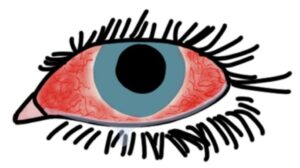Scleritis involves inflammation of the sclera. The sclera is the outer layer of connective tissue surrounding most of the eye (excluding the cornea). It forms the visible white part of the eye.

The most severe type of scleritis is called necrotising scleritis, which can lead to perforation of the sclera.
Most cases are idiopathic (no clear cause) or associated with an underlying systemic inflammatory condition. Less commonly, it can be due to infection (e.g., Pseudomonas or Staphylococcus aureus). It is more common in women.
Associated Systemic Conditions
There is an associated systemic condition in around 50% of patients presenting with scleritis, particularly:
- Rheumatoid arthritis
- Vasculitis, particularly granulomatosis with polyangiitis)
TOM TIP: The connective tissue of the sclera is relatively similar to connective tissue in joints, so it may be affected in rheumatoid arthritis. It is worth remembering the difference between the conditions associated with scleritis (rheumatoid arthritis and vasculitis) and anterior uveitis (seronegative spondyloarthropathies).
Presentation
Scleritis usually presents with a more gradual onset. It can be unilateral or bilateral. Features include:
- Red, inflamed sclera (localised or diffuse)
- Congested vessels
- Severe pain (typically a boring pain)
- Pain with eye movement
- Photophobia
- Epiphora (excessive tear production)
- Reduced visual acuity
- Tenderness to palpation of the eye
Management
Patients should be referred for urgent assessment and management by an ophthalmologist. Patients should be assessed for an underlying systemic condition (e.g., rheumatoid arthritis or vasculitis).
Management in secondary care may involve:
- NSAIDs (oral)
- Steroids (topical or systemic)
- Immunosuppression appropriate to the underlying systemic condition (e.g., methotrexate in rheumatoid arthritis)
Antimicrobial treatment is required for infectious scleritis.
Last updated October 2023
Now, head over to members.zerotofinals.com and test your knowledge of this content. Testing yourself helps identify what you missed and strengthens your understanding and retention.

